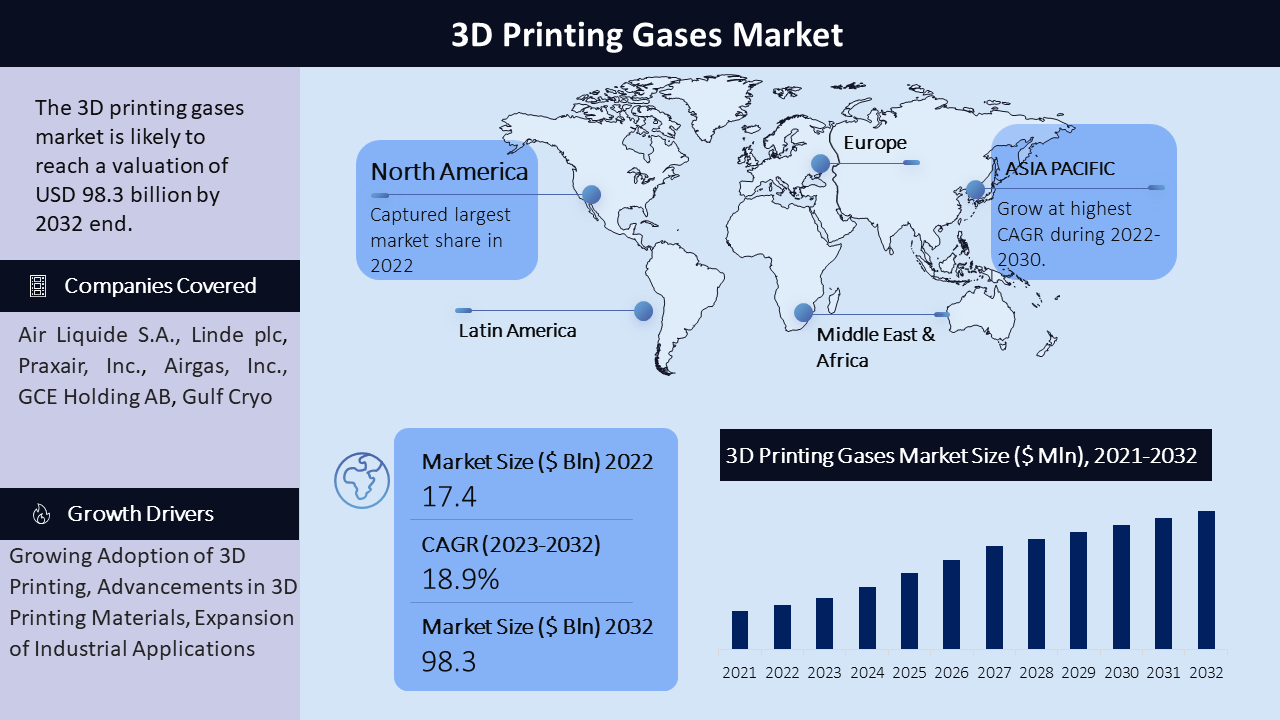3D Printing Gases Market - Global Size, Share, Trends, Growth and Forecast Year ( 2022 – 2032 )
3D Printing Gases Market Overview, Size and Share
As per the KD Market Insights, the global 3D printing market size accounted for USD 17.4 billion in 2022 and it is expected to reach around USD 98.3 billion by 2032 and is poised to grow at a CAGR of 19.1% from 2023 to 2032. In order to promote the growth and development of additive manufacturing processes, 3D printing gases works in conjunction with the broader 3D printing industry. The availability of specialized gases and their optimal use helps to produce 3D printed parts of high quality and unlock new applications in various sectors.
3D Printing Gases Market Segmentation
Some segmentations of the 3D printing gases market include:
By Gas Type:
- Inert Gases
- Reactive Gases
- Support Gases
By Technology:
- Powder Bed Fusion (PBF)
- Fused Deposition Modelling (FDM)
- Stereolithography (SLA) and Digital Light Processing (DLP)
- Others
By Application:
- Aerospace
- Automotive
- Healthcare
- Consumer Goods
- Others
By Geography:
- North America
- Europe
- Asia Pacific
- Latin America
- The Middle East and Africa
The inert gases segment is leading in the 3D printing gases market. Inert gases, such as nitrogen and argon, are widely used in 3D printing processes to create controlled atmospheres, prevent oxidation, and provide a stable environment for printing various materials.
|
3D Printing Gases Market: Report Scope |
|
|
Base Year Market Size |
2022 |
|
Forecast Year Market Size |
2023-2032 |
|
CAGR Value |
19.1% |
|
Segmentation |
|
|
Challenges |
|
|
Growth Drivers |
|
3D Printing Gases Market Regional Synopsis
The report analyses North America, Europe, Asia Pacific, Latin America and Middle East & Africa. The demand for 3D printing is high in North America. Key firms are well-present in the region, and the additive manufacturing industry is well-established. The region's demand for 3D printing gases is driven by industries like aerospace, automotive, and healthcare.
In 2022, Europe accounted for second largest market share among all regions. Strong industrial sectors are present in countries like Germany, the United Kingdom, and France, and thus are driving 3D printing usage. The emphasis on sustainability in the region is further aiding to the growth of market.
The demand for 3D printing products is expanding quickly in the Asia-Pacific area. Countries like China, Japan, and South Korea are witnessing increased adoption in 3D printing technology as well as an increase in demand for products in industries like consumer goods, healthcare, and automotive.
A growing demand for 3D printing gases is also coming from Latin America. Countries like Brazil and Mexico exhibit increasing 3D printing technology abandonment, providing demand development opportunities. The demand for gases in the area is influenced by demand in the automobile and healthcare industries.
The market for 3D printing gases shows growth potential in the Middle East and Africa too. Increasing adoption of 3D printing technology is witnessed in nations like the United Arab Emirates and South Africa, particularly in industries such as architecture, healthcare, and manufacturing.
3D Printing Gases Market Driving Factors
The increasing adoption of 3D printing technology in industries such as aerospace, automotive, healthcare, and consumer goods is fuelling the need for the materials utilized in 3D printing processes. Specific gases are needed to optimize printing conditions and achieve desired material properties while developing new 3D printing-compatible materials, such as metal alloys and advanced polymers. As the use of 3D printing for industrial applications such as prototyping, tooling, and customized part production increases, there is an increasing need for gases to support these processes.
New developments in 3D printing technology, such as powder bed fusion and resin-based processes, require precise gas control for improved print quality, part accuracy, and productivity.
The demand for environmentally friendly and sustainable manufacturing processes is also a significant factor driving the adoption of gases that minimize environmental impact, such as inert gases that reduce oxidation and enable the effective material application.
3D Printing Gases Market Challenges
The options and applicability of gases for various applications are limited since some gases are particular to 3D printing process or materials. Some of the specialized gases in 3D printing are expensive, affecting the printing process' overall cost, especially for small-scale users or applications with limited funding.
Safety protocols and regulations must be followed when handling, storing, and transporting gases. It can be difficult to ensure proper safety measures, especially for users who lack technical training or knowledge.

3D Printing Gases Market Key Players
Some notable companies operating in this space:
- Air Liquide S.A.
- Linde plc
- Praxair, Inc.
- Air Products and Chemicals, Inc.
- Messer Group GmbH
- Matheson Tri-Gas, Inc.
- Iwatani Corporation
- Airgas, Inc.
- Advanced Specialty Gases, Inc.
- GCE Holding AB
- Buzwair Industrial Gases Factory
- Universal Industrial Gases, Inc.
- Coregas Pty Ltd
- Taiyo Nippon Sanso Corporation (TNSC Group)
- Gulf Cryo
- Others

Need Customized Report for Your Business ?
Utilize the Power of Customized Research Aligned with Your Business Goals
Request for Customized Report- Quick Contact -
- ISO Certified Logo -

















